HONDA CIVIC SEDAN 2012 Owner's Manual (in English)
Manufacturer: HONDA, Model Year: 2012, Model line: CIVIC SEDAN, Model: HONDA CIVIC SEDAN 2012Pages: 345, PDF Size: 53.95 MB
Page 221 of 345
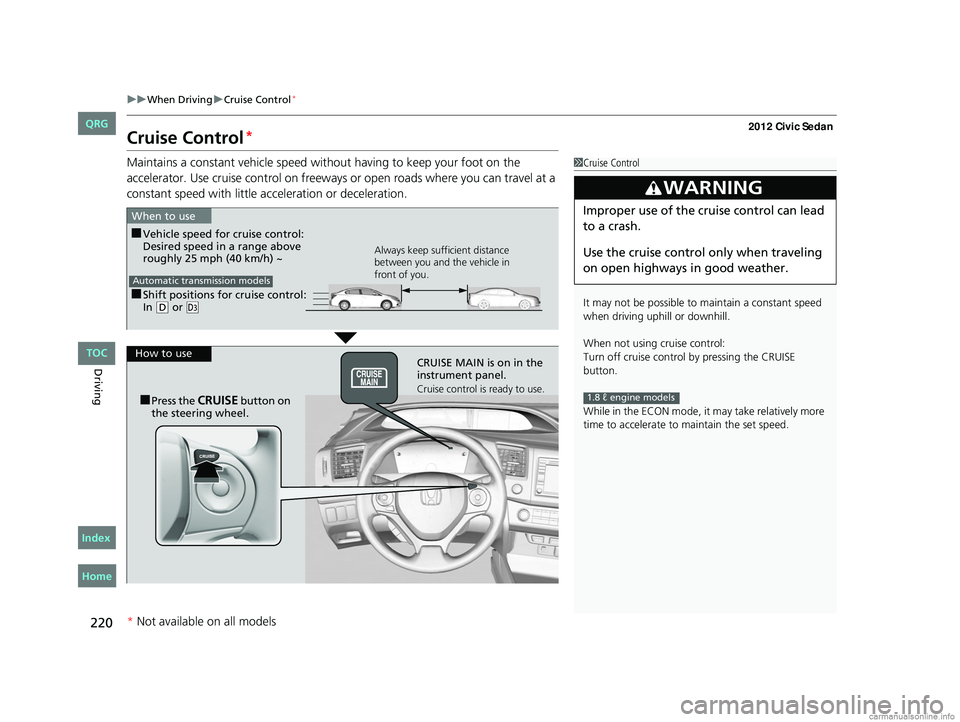
220
uuWhen Driving uCruise Control*
Driving
Cruise Control*
Maintains a constant vehicle speed without having to keep your foot on the
accelerator. Use cruise control on freeways or open roads where you can travel at a
constant speed with little acceleration or deceleration.1Cruise Control
It may not be possible to maintain a constant speed
when driving uphill or downhill.
When not using cruise control:
Turn off cruise control by pressing the CRUISE
button.
While in the ECON mode, it may take relatively more
time to accelerate to maintain the set speed.
3WARNING
Improper use of the cruise control can lead
to a crash.
Use the cruise control only when traveling
on open highways in good weather.
1.8 ℓ engine models
■Shift positions fo r cruise control:
In ( D or (d
When to use
Always keep sufficient distance
between you and the vehicle in
front of you.
Automatic transmission models
■Vehicle speed for cruise control:
Desired speed in a range above
roughly 25 mph (40 km/h) ~
How to use CRUISE MAIN is on in the
instrument panel.
Cruise control is ready to use.■Press the CRUISE button on
the steering wheel.
* Not available on all models
CIVIC 4D-31TR3600.book 220 ページ 2011年2月14日 月曜日 午後2時51分
TOC
Home
QRG
Index
Page 222 of 345
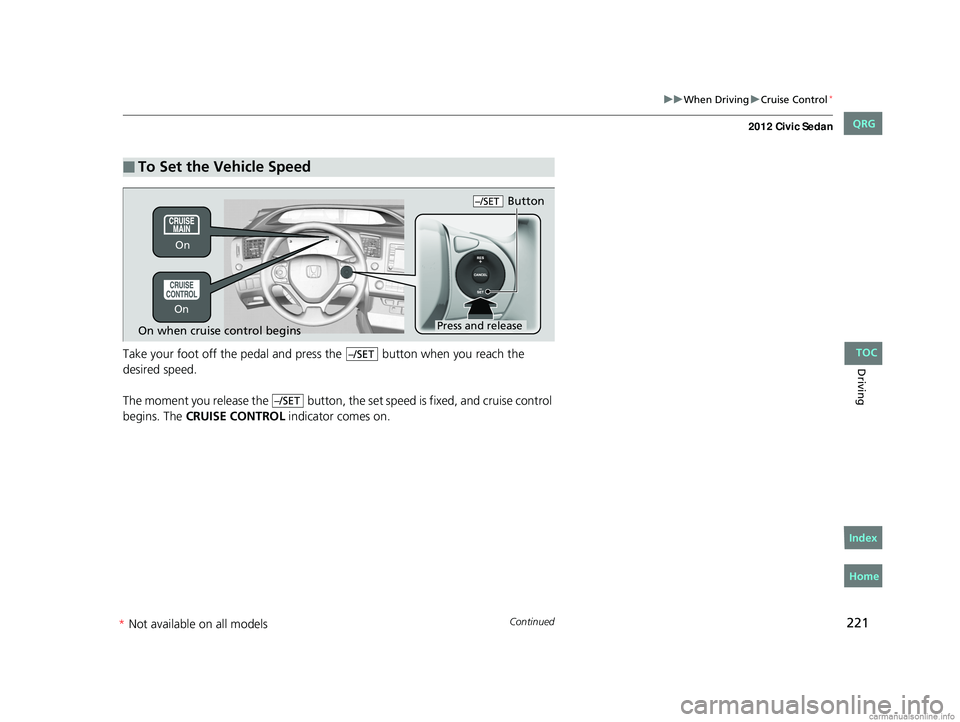
221
uuWhen Driving uCruise Control*
Continued
DrivingTake your foot off the pedal and pr ess the button when you reach the
desired speed.
The moment you release the button, the set speed is fixed, and cruise control
begins. The CRUISE CONTROL indicator comes on.
■To Set the Vehicle Speed
Button–/SET
On when cruise control beginsPress and release
On On
–/SET
–/SET
CIVIC 4D-31TR3600.book 221 ページ 2011年2月14日 月曜日 午後2時51分
TOC
*
Not av ailable on all mo dels
Home
QRG
Index
Page 223 of 345
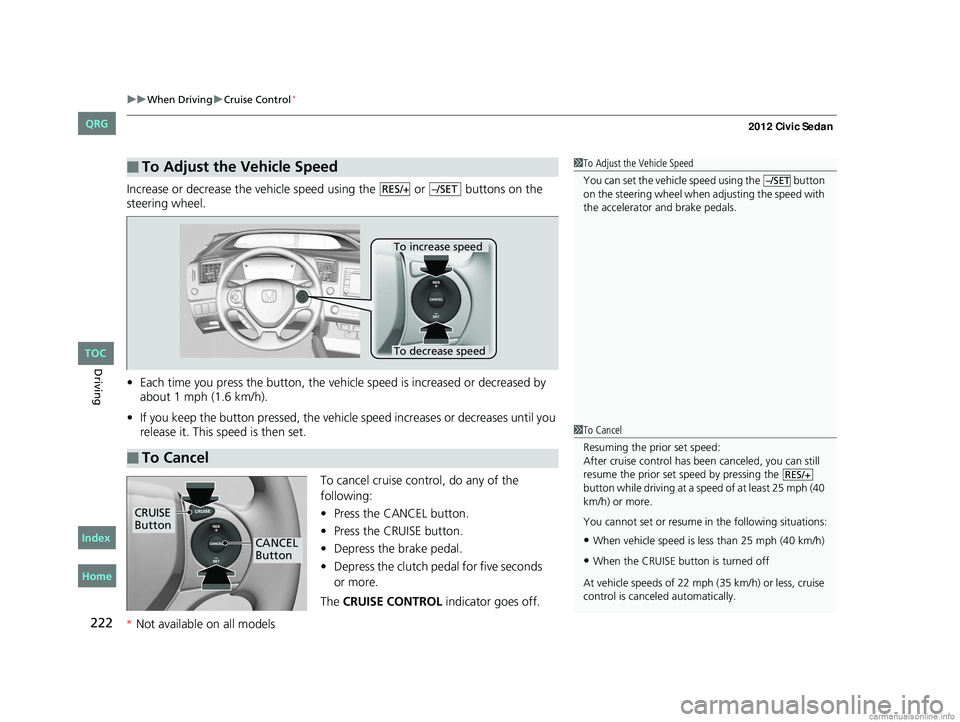
uuWhen Driving uCruise Control*
222
Driving
Increase or decrease the vehicle speed using the or buttons on the
steering wheel.
• Each time you press the button, the vehicl e speed is increased or decreased by
about 1 mph (1.6 km/h).
• If you keep the button pressed, the vehicl e speed increases or decreases until you
release it. This speed is then set.
To cancel cruise control, do any of the
following:
•Press the CANCEL button.
• Press the CRUISE button.
• Depress the brake pedal.
• Depress the clutch pedal for five seconds
The CRUISE CONTROL indicator goes off.
■To Adjust the Vehicle Speed1To Adjust the Vehicle Speed
You can set the vehicle speed using the button
on the steering wheel when adjusting the speed with
the accelerator and brake pedals.
–/SETRES/+–/SET
■To Cancel
To decrease speed
To increase speed
1To Cancel
Resuming the prior set speed:
After cruise control has be en canceled, you can still
resume the prior set speed by pressing the
button while driving at a speed of at least 25 mph (40
km/h) or more.
You cannot set or resume in the following situations:
•When vehicle speed is less than 25 mph (40 km/h)
•When the CRUISE button is turned off
At vehicle speeds of 22 m ph (35 km/h) or less, cruise
control is canceled automatically.
RES/+
CRUISE
Button
CANCEL
Button
CIVIC 4D-31TR3600.book 222 ページ 2011年2月14日 月曜日 午後2時51分
TOC
Home
QRG
Index
* Not available on all models
or more.
Page 224 of 345
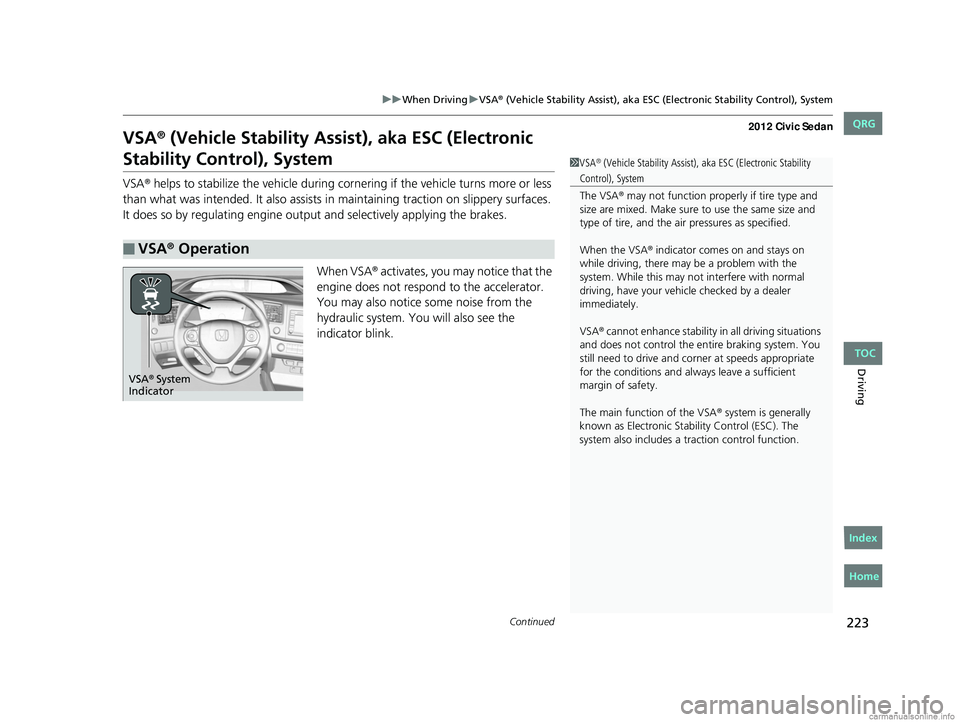
223
uuWhen Driving uVSA® (Vehicle Stability Assist), aka ESC (Electronic Stability Control), System
Continued
Driving
VSA® (Vehicle Stability Assist ), aka ESC (Electronic
Stability Control), System
VSA® helps to stabilize the vehicle during corn ering if the vehicle turns more or less
than what was intended. It also assists in maintaining traction on slippery surfaces.
It does so by regulating engine ou tput and selectively applying the brakes.
When VSA
® activates, you may notice that the
engine does not respond to the accelerator.
You may also notice some noise from the
hydraulic system. You will also see the
indicator blink.
■VSA® Operation
1 VSA® (Vehicle Stability Assist), aka ESC (Electronic Stability
Control), System
The VSA
® may not function prope rly if tire type and
size are mixed. Make sure to use the same size and
type of tire, and the air pressures as specified.
When the VSA
® indicator comes on and stays on
while driving, there may be a problem with the
system. While this may not interfere with normal
driving, have your vehi cle checked by a dealer
immediately.
VSA
® cannot enhance stability in all driving situations
and does not control the entire braking system. You
still need to drive and corner at speeds appropriate
for the conditions and always leave a sufficient
margin of safety.
The main function of the VSA
® system is generally
known as Electronic Stability Control (ESC). The
system also includes a traction control function.
VSA® System
Indicator
CIVIC 4D-31TR3600.book 223 ページ 2011年2月14日 月曜日 午後2時51分
TOC
Home
QRG
Index
Page 225 of 345
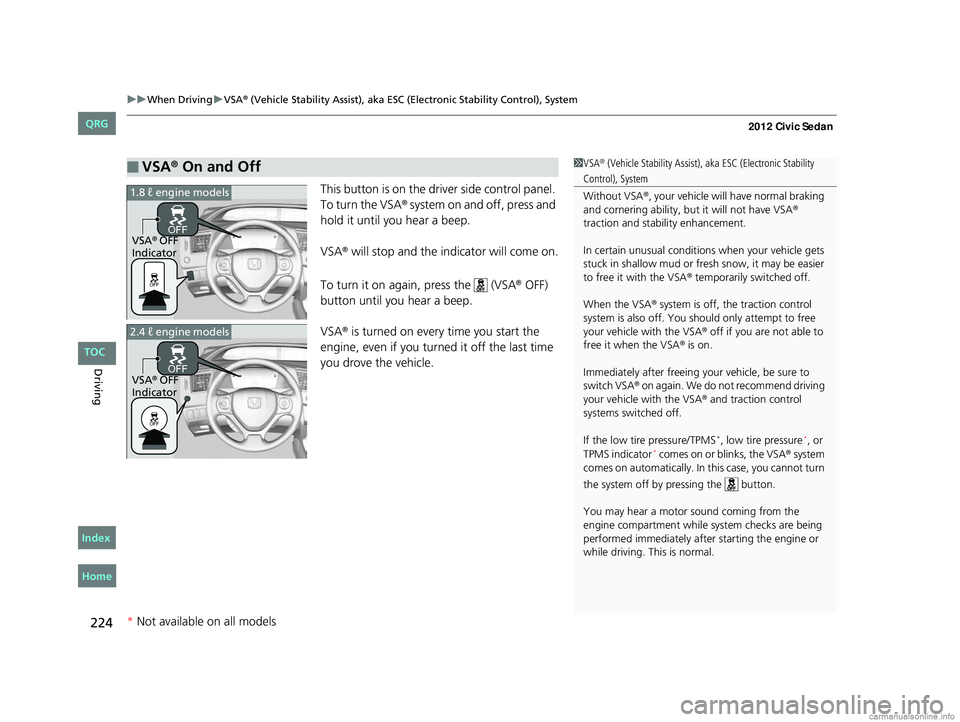
uuWhen Driving uVSA® (Vehicle Stability Assist), aka ESC (Electronic Stability Control), System
224
Driving
This button is on the driver side control panel.
To turn the VSA® system on and off, press and
hold it until you hear a beep.
VSA
® will stop and the indicator will come on.
To turn it on again, press the (VSA
® OFF)
button until you hear a beep.
VSA
® is turned on every time you start the
engine, even if you turned it off the last time
you drove the vehicle.
■VSA® On and Off1 VSA® (Vehicle Stability Assist), aka ESC (Electronic Stability
Control), System
Without VSA
®, your vehicle will have normal braking
and cornering ability, bu t it will not have VSA®
traction and stability enhancement.
In certain unusual conditions when your vehicle gets
stuck in shallow mud or fr esh snow, it may be easier
to free it with the VSA
® temporarily switched off.
When the VSA
® system is off, the traction control
system is also off. You should only atte mpt to free
your vehicle with the VSA
® off if you are not able to
free it when the VSA® is on.
Immediately after freeing your vehicle, be sure to
switch VSA
® on again. We do not recommend driving
your vehicle with the VSA® and traction control
systems switched off.
If the low tire pressure/TPMS
*, low tire pressure*, or
TPMS indicator* comes on or blinks, the VSA® system
comes on automatically. In this case, you cannot turn
the system off by pressing the button.
You may hear a motor sound coming from the
engine compartment while system checks are being
performed immediately after starting the engine or
while driving. This is normal.
VSA® OFF
Indicator
1.8 ℓ engine models
VSA® OFF
Indicator
2.4 ℓ engine models
* Not available on all models
CIVIC 4D-31TR3600.book 224 ページ 2011年2月14日 月曜日 午後2時51分
TOC
Home
QRG
Index
Page 226 of 345
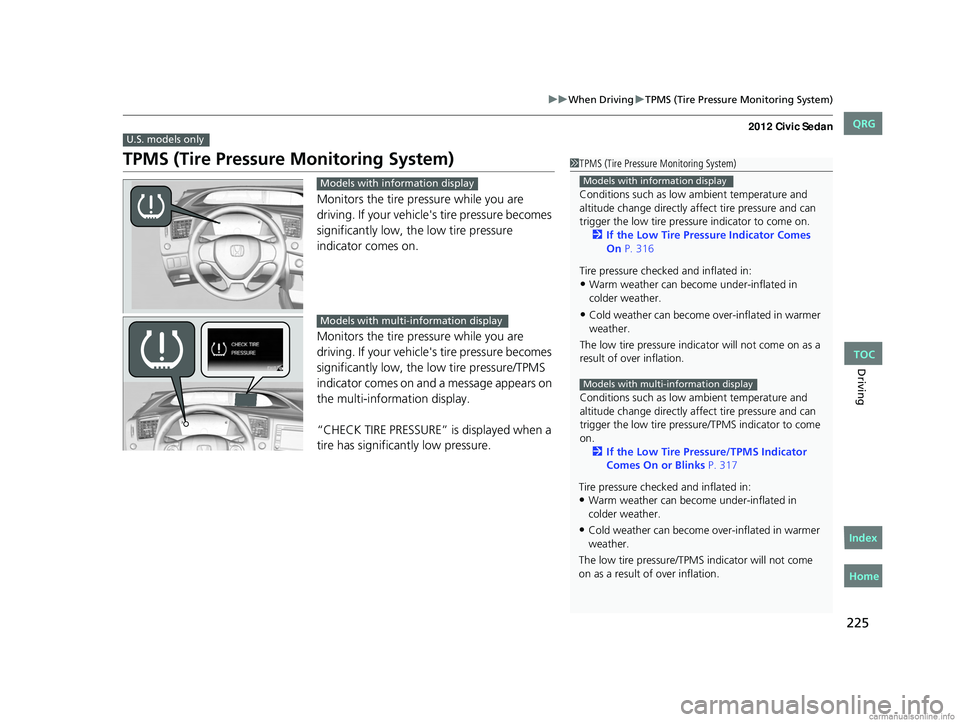
225
uuWhen Driving uTPMS (Tire Pressure Monitoring System)
Driving
TPMS (Tire Pressure Monitoring System)
Monitors the tire pr essure while you are
driving. If your vehicle's tire pressure becomes
significantly low, th e low tire pressure
indicator comes on.
Monitors the tire pr essure while you are
driving. If your vehicle's tire pressure becomes
significantly low, the low tire pressure/TPMS
indicator comes on and a message appears on
the multi-information display.
“CHECK TIRE PRESSURE” is displayed when a
tire has significantly low pressure.
U.S. models only
1 TPMS (Tire Pressure Monitoring System)
Conditions such as low ambient temperature and
altitude change directly affect tire pressure and can
trigger the low tire pressure indicator to come on.
2 If the Low Tire Pressure Indicator Comes
On P. 316
Tire pressure checked and inflated in:
•Warm weather can beco me under-inflated in
colder weather.
•Cold weather can become over-inflated in warmer
weather.
The low tire pressure indica tor will not come on as a
result of over inflation.
Conditions such as low ambient temperature and
altitude change directly affect tire pressure and can
trigger the low tire pressure/TPMS indicator to come
on. 2 If the Low Tire Pressure/TPMS Indicator
Comes On or Blinks P. 317
Tire pressure checked and inflated in:
•Warm weather can beco me under-inflated in
colder weather.
•Cold weather can become over-inflated in warmer
weather.
The low tire pressure/TPMS indicator will not come
on as a result of over inflation.
Models with information display
Models with multi-information display
Models with info rmation display
Models with multi- information display
CIVIC 4D-31TR3600.book 225 ページ 2011年2月14日 月曜日 午後2時51分
TOC
Home
QRG
Index
Page 227 of 345
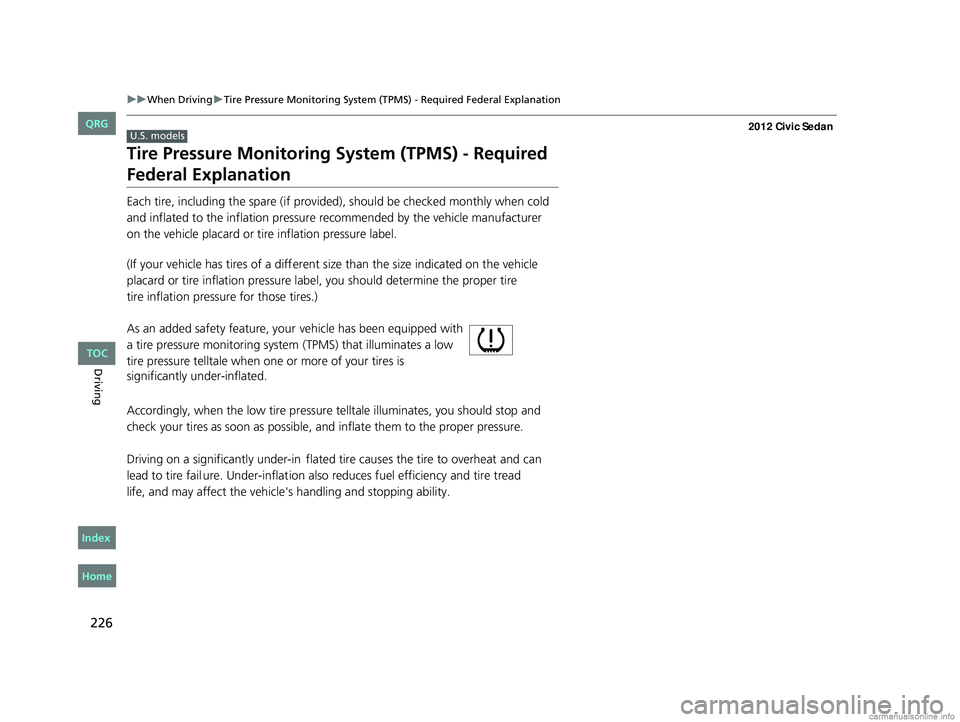
226
uuWhen Driving uTire Pressure Monitoring System (TPMS) - Required Federal Explanation
Driving
Tire Pressure Monitoring System (TPMS) - Required
Federal Explanation
Each tire, including the spare (if provided), should be checked monthly when cold
and inflated to the inflation pressure recommended by the vehicle manufacturer
on the vehicle placard or tire inflation pressure label.
(If your vehicle has tires of a diff erent size than the size indicated on the vehicle
placard or tire inflation pressure label, you should determine the proper tire
tire inflation pressure for those tires.)
As an added safety feature, your vehicle has been equipped with
a tire pressure monitoring system (TPMS) that illuminates a low
tire pressure telltale when one or more of your tires is
significantly under-inflated.
Accordingly, when the low tire pressure telltale illuminates, you should stop and
check your tires as soon as possible, and inflate them to the proper pressure.
Driving on a significantly under-in flated tire causes the tire to overheat and can
lead to tire fail ure. Under-inflation also reduces fuel efficiency and tire tread
life, and may affect the vehicle's handling and stopping ability.
U.S. models
CIVIC 4D-31TR3600.book 226 ページ 2011年2月14日 月曜日 午後2時51分
TOC
Home
QRG
Index
Page 228 of 345
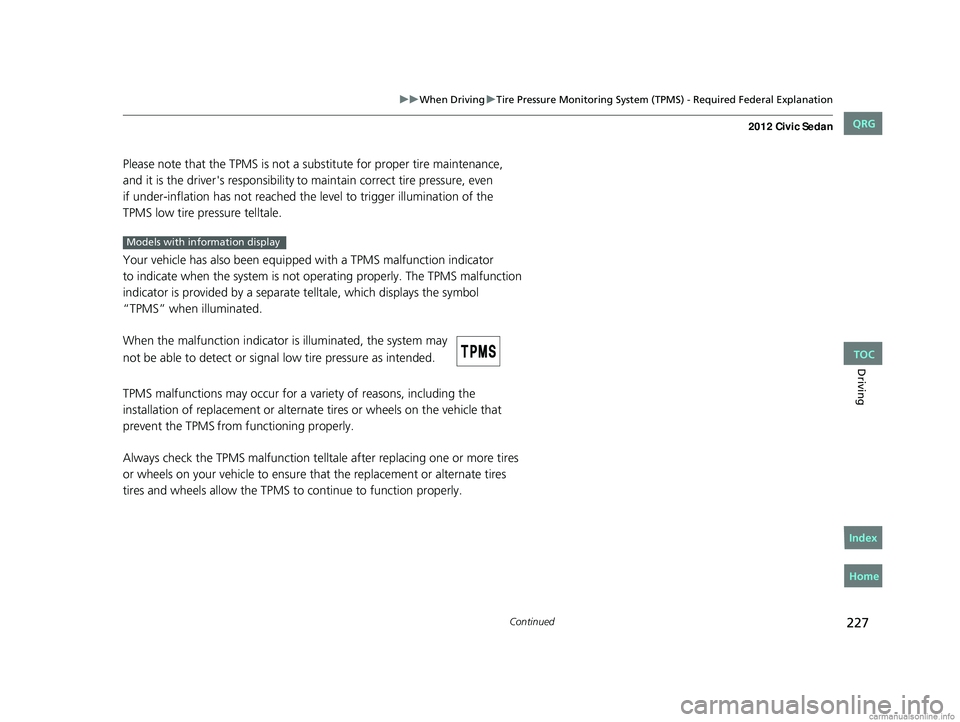
227
uuWhen Driving uTire Pressure Monitoring System (TPMS) - Required Federal Explanation
Continued
Driving
Please note that the TPMS is not a substitute for proper tire maintenance,
and it is the driver's responsibility to maintain correct tire pressure, even
if under-inflation has not reached the level to trigger illumination of the
TPMS low tire pressure telltale.
Your vehicle has also been equipped with a TPMS malfunction indicator
to indicate when the system is not operating properly. The TPMS malfunction
indicator is provided by a separate telltale, which displays the symbol
“TPMS” when illuminated.
When the malfunction indicator is illuminated, the system may
not be able to detect or signal low tire pressure as intended.
TPMS malfunctions may occur for a variety of reasons, including the
installation of replacement or alternate tires or wheels on the vehicle that
prevent the TPMS from functioning properly.
Always check the TPMS malfunction telltale after replacing one or more tires
or wheels on your vehicle to ensure that the replacement or alternate tires
tires and wheels allow the TPMS to continue to function properly.
Models with info rmation display
CIVIC 4D-31TR3600.book 227 ページ 2011年2月14日 月曜日 午後2時51分
TOC
Home
QRG
Index
Page 229 of 345
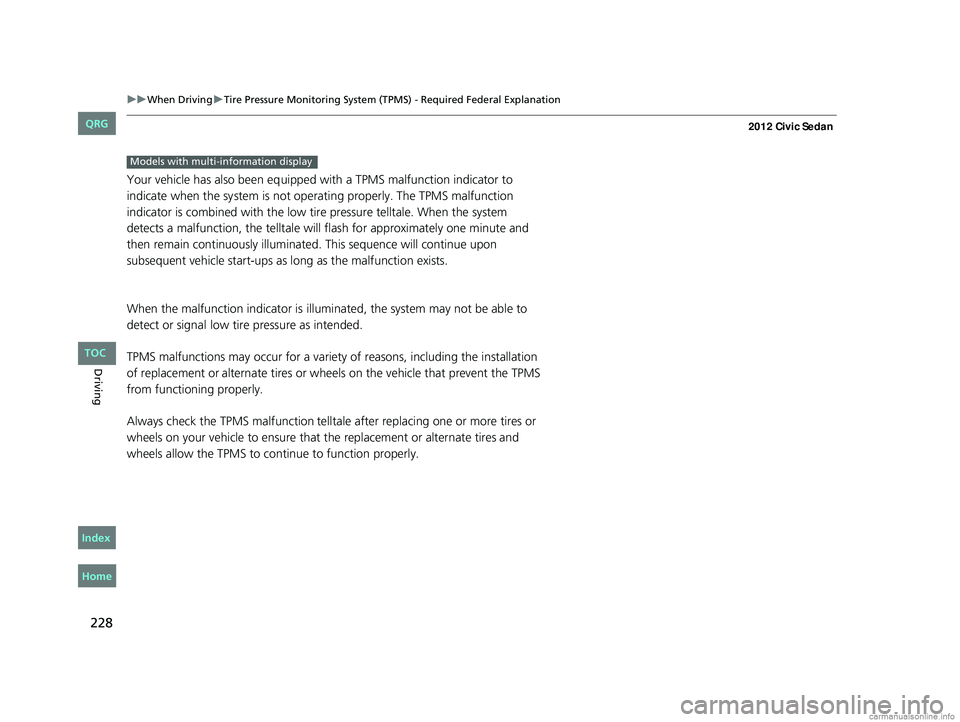
228
uuWhen Driving uTire Pressure Monitoring System (TPMS) - Required Federal Explanation
Driving
Your vehicle has also been eq uipped with a TPMS malfunction indicator to
indicate when the system is not operating properly. The TPMS malfunction
indicator is combined with the low tire pressure telltale. When the system
detects a malfunction, the telltale will flash for approximately one minute and
then remain continuously illuminated. This sequence will continue upon
subsequent vehicle start-ups as long as the malfunction exists.
When the malfunction indicator is illuminated, the system may not be able to
detect or signal low tire pressure as intended.
TPMS malfunctions may occur for a variety of reasons, including the installation
of replacement or alternate tires or wheels on the vehicle that prevent the TPMS
from functioning properly.
Always check the TPMS malfunction telltale after replacing one or more tires or
wheels on your vehicle to ensure that the replacement or alternate tires and
wheels allow the TPMS to continue to function properly.
Models with multi- information display
CIVIC 4D-31TR3600.book 228 ページ 2011年2月14日 月曜日 午後2時51分
TOC
Home
QRG
Index
Page 230 of 345

229Continued
Driving
Braking
Brake System
Use the parking brake to keep the vehicle stationary when parking.To apply:
Pull the lever fully up without pressing the
release button.
To release:
1.Pull the lever slightly, and press and hold
the release button.
2. Lower the lever down all the way, then
release the button.
■Parking Brake1Parking Brake
NOTICE
Release the parking brake fu lly before driving. The
rear brakes and axle can be damaged if you drive
with the parki ng brake applied.
If you start driving without fully releasing the parking
brake, a buzzer sounds as a warning, and "RELEASE
PARKING BRAKE" appears on the multi-information
display
*.
Always apply the parking brake when parking.
To prevent the parking brake from freezing when the
outside temperature is ex tremely cold, do not apply
it, but do the following:
Put the shift lever in
( P, then use a block or other
wheel chock to stop the wheels from turning.
Put the shift lever in
( R or (1, then use a block or
other wheel chock to stop the wheels from turning.
Automatic transmission models
Manual transmission models
* Not available on all models
CIVIC 4D-31TR3600.book 229 ページ 2011年2月14日 月曜日 午後2時51分
TOC
Home
QRG
Index